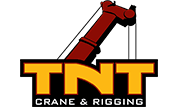Differences Between Lifting and Rigging
Construction | Feb 14 / 24
The terms “lifting” and “rigging” are common terms in construction projects. While these terms are often used interchangeably, there are differences between lifting and rigging. The team at TNT Crane & Rigging has put together some information about the key differences between these two essential stages of any successful crane operation.
Lifting vs. Rigging
Lifting and rigging are often used interchangeably, but they refer to distinct stages in a crane operation. Lifting involves the actual raising and lowering of loads, while rigging focuses on the intricate process of preparing and securing those loads for safe and efficient lifting. Simply put, lifting is the action, and rigging is the preparation.
The Lifting Process
Lifting, as mentioned earlier, is the action of raising or lowering heavy objects. This phase involves the use of cranes or other lifting equipment. TNT Crane & Rigging provides a large selection of specialized equipment for various lifting needs. We can help you choose the right equipment for the job, ensuring that each operation is executed with precision and safety in mind.
Load Positioning
Before any lifting takes place, it is crucial to position the load correctly. This includes ensuring that the load is balanced and secured to prevent swinging or instability during the lift.
Load Hook-Up
The load is attached to the crane’s hook using appropriate rigging equipment, such as slings, chains, or hooks. Proper attachment is essential to distribute the load’s weight evenly and prevent accidents.
Lifting Execution
Once the load is securely attached, the crane operator carefully raises or lowers it to the desired location. The operator’s skill and precision play a critical role in this phase, avoiding accidents and damage to the load or equipment.
The Rigging Process
Rigging is the preparatory work that ensures a load is ready for lifting. It involves selecting the right rigging equipment and configurations to safely secure and stabilize the load during lifting.
Rigging Equipment Selection
Choosing the appropriate slings, shackles, hooks, and other rigging hardware is essential. The load’s weight, shape, and centre of gravity must be considered to determine the right equipment.
Load Assessment
Rigging experts assess the load’s characteristics, including its weight, size, and fragility. This assessment helps determine the safest and most efficient rigging configuration.
Rigging Plan
A detailed rigging plan is developed, outlining the rigging configuration, attachment points, crane’s lifting capacity, and the order of operations. This plan ensures that everyone involved in the operation understands their role and the safety precautions that need to be taken.
Load Securing
Rigging professionals meticulously secure the load using the chosen equipment, following the rigging plan’s specifications. Proper load securing prevents shifting, swinging, or falling during the lift.
If you need assistance with lifting and rigging planning and execution, TNT Crane & Rigging is here for you. Contact us via our toll-free number at 1-833-479-7833.
The terms “lifting” and “rigging” are common terms in construction projects. While these terms are often used interchangeably, there are differences between lifting and rigging. The team at TNT Crane & Rigging has put together some information about the key differences between these two essential stages of any successful crane operation.
Lifting vs. Rigging
Lifting and rigging are often used interchangeably, but they refer to distinct stages in a crane operation. Lifting involves the actual raising and lowering of loads, while rigging focuses on the intricate process of preparing and securing those loads for safe and efficient lifting. Simply put, lifting is the action, and rigging is the preparation.
The Lifting Process
Lifting, as mentioned earlier, is the action of raising or lowering heavy objects. This phase involves the use of cranes or other lifting equipment. TNT Crane & Rigging provides a large selection of specialized equipment for various lifting needs. We can help you choose the right equipment for the job, ensuring that each operation is executed with precision and safety in mind.
Load Positioning
Before any lifting takes place, it is crucial to position the load correctly. This includes ensuring that the load is balanced and secured to prevent swinging or instability during the lift.
Load Hook-Up
The load is attached to the crane’s hook using appropriate rigging equipment, such as slings, chains, or hooks. Proper attachment is essential to distribute the load’s weight evenly and prevent accidents.
Lifting Execution
Once the load is securely attached, the crane operator carefully raises or lowers it to the desired location. The operator’s skill and precision play a critical role in this phase, avoiding accidents and damage to the load or equipment.
The Rigging Process
Rigging is the preparatory work that ensures a load is ready for lifting. It involves selecting the right rigging equipment and configurations to safely secure and stabilize the load during lifting.
Rigging Equipment Selection
Choosing the appropriate slings, shackles, hooks, and other rigging hardware is essential. The load’s weight, shape, and centre of gravity must be considered to determine the right equipment.
Load Assessment
Rigging experts assess the load’s characteristics, including its weight, size, and fragility. This assessment helps determine the safest and most efficient rigging configuration.
Rigging Plan
A detailed rigging plan is developed, outlining the rigging configuration, attachment points, crane’s lifting capacity, and the order of operations. This plan ensures that everyone involved in the operation understands their role and the safety precautions that need to be taken.
Load Securing
Rigging professionals meticulously secure the load using the chosen equipment, following the rigging plan’s specifications. Proper load securing prevents shifting, swinging, or falling during the lift.
If you need assistance with lifting and rigging planning and execution, TNT Crane & Rigging is here for you. Contact us via our toll-free number at 1-833-479-7833.

